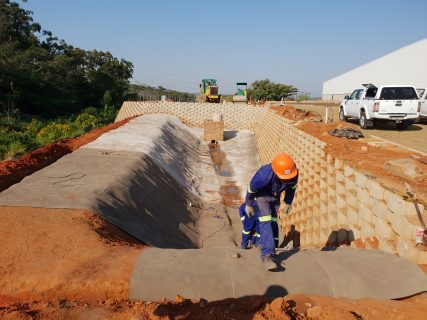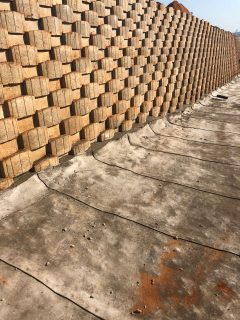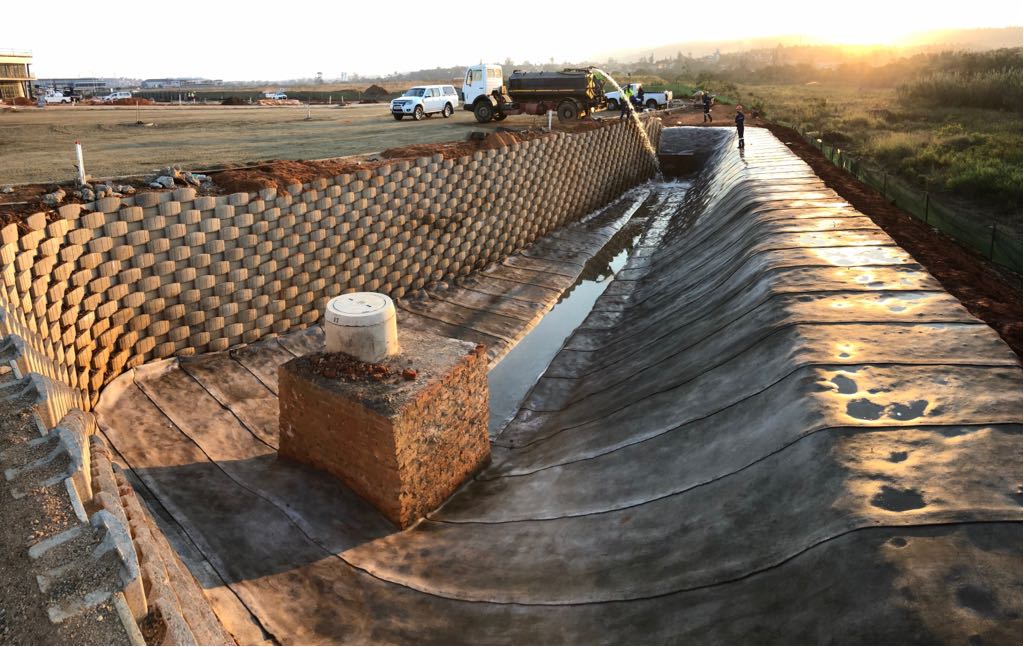Concrete is the world’s most widely used construction material, and it’s used in countless projects around Africa. However, over the last ten years, another material has started to see more use in civil engineering projects, particularly in South Africa. Concrete Canvas, sometimes known as ‘concrete on a roll’ because of how it arrives on-site, is a concrete-filled fabric that was developed by two university students in the UK. After initial development to create semi-permanent disaster relief shelters, Will Crawford and Peter Brewin started a company (Concrete Canvas) in 2005 and then shifted focus to producing the fabric.
The fabric they created works in a totally different way to traditional concrete, as it requires no mixing or specialist equipment on site. It arrives ready to be installed on a large roll, and the fabric can be cut to the size needed for any project with simple hand tools. Once in place, the fabric strips need to be secured and hydrated. After being left to dry for 24 hours, the fabric will have hardened into a concrete layer.
Application of Concrete Canvas
Classed as a Geosynthetic Cementitious Composite Mat (GCCM), Concrete Canvas has been used on a wide variety of civil engineering projects. It is commonly used for channel or ditch lining, but it can also be used for concrete resurfacing.

This fabric has already been used in several projects in Africa, most recently in South Africa 2 years ago. The New Print Park, Cornubia in Durban required a new attenuation pond. This is a temporary stormwater storage facility for water runoff from the park property. The pond is designed to reduce the effects of flooding, which can be common and extremely dangerous in built-up areas.
An inlet pipe to the pond measured 600mm in diameter in comparison to the 300mm in diameter outflow pipe. This means the pond is designed to store the difference between the two pipes as the water drains away.
Advantages of Concrete Canvas over traditional concrete
Concrete Canvas was chosen for the stormwater storage facility project in Durban as the site had limited access and the project needed to be completed quickly. These are two areas where Concrete Canvas has significant advantages over traditional concrete.
As poured or sprayed concrete needs to be mixed on-site, large machinery is needed. When access is limited, this makes it very difficult to get the required machinery in place. With Concrete Canvas, as it is transported to the site on a palletized roll, it was ready to be installed as soon as it arrived.
With this project, the speed of installation was also vital. It was important the installation of the fabric did not do damage the surrounding area as this could cause problems in the event of a sudden rainfall event. The speed at which Concrete Canvas can be installed and be ready to use after drying makes its installation up to ten times faster than poured or sprayed concrete.
 Once the material was in place, it was secured with 30mm stainless steel screws at 200mm intervals, and thoroughly hydrated. To ensure the Concrete Canvas was fully saturated, it was sprayed with water four times at 30-minute intervals to combat the dry climatic conditions.
Once the material was in place, it was secured with 30mm stainless steel screws at 200mm intervals, and thoroughly hydrated. To ensure the Concrete Canvas was fully saturated, it was sprayed with water four times at 30-minute intervals to combat the dry climatic conditions.
The project needed only six workers to complete and was finished on time and within budget. In total 375m2 of Concrete Canvas fabric was installed, and it proved a success as the attenuation pond has since withstood a 1:50 year rainfall event which caused significant flooding to the region.

